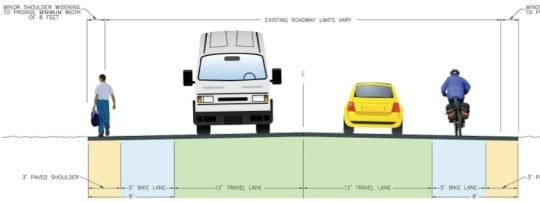
Well, our hopes for a protected bikeway on SE Powell Blvd have been dashed. At least for now.
Back in October we shared news that ODOT wanted feedback on how to make SE Powell between SE 111th and SE 174th (map) safer for all users. Their $5.5 million Outer Powell Safety Improvements project is focused “on strategic safety improvements” as well as repaving.

(Photo: ODOT)
We hoped there would be a possibility to push for something more than standard five-foot bike lanes with no separation between motorized traffic. Prior to their October open house on the project, ODOT wanted input on, “How to modify and better delineate the road shoulder and roadway striping to reduce conflicts between vehicles, pedestrians, and cyclists.” We thought that might have meant some sort of protected bikeway; but unfortunately it turns out they just wanted to know what type of striping to use. The actual width and design of the lanes themselves was not on the table.
ODOT Community Affairs staffer Shelli Romero said people at the open house were shown a few different types of bike lane striping — yellow or white stripes with bumps or without bumps. “People said they wanted the most durable and visible striping possible… And they like louder treatments. The louder the better so cars don’t cross over.”
ODOT showed the image below as an example…

As you can see in the cross-section graphic above, ODOT plans to have two 12-foot wide standard lanes next to a five-foot bike lane and a three-foot shoulder for people to walk on. There are no sidewalks on this stretch of Powell, and Romero says unfortunately this project’s budget and scope don’t allow for putting them in (Romero also said ODOT is mindful of Metro’s forthcoming high-capacity transit corridor planning process on Powell which might lead to a larger investment and/or widening, etc…).
So instead of crosswalks, the eight-foot outer lanes will be shared by people biking and walking. While common on rural roads around the state, this biking/walking mix is new for urban areas, Romero said.
Left with just a five-foot wide travel lane for bicycling, I asked Romero why they insist on keeping the other travel lane 12 feet wide. There are many 10-foot wide lanes throughout the city. Romero said Powell is classified as a “major truck street” and it’s also a highly used transit line. TriMet bus mirrors, she said, make the vehicles 10.5 feet wide and “They need those 12-foot lanes to avoid wavering into that bike lane,” Romero said. “For that reason, we don’t consider narrowing the lane to give another foot or so to bikes.”

The graphic below is from the NACTO Urban Bikeway Design Guide. It’s a good visual of bike lane widths:

I understand trucks and bus operators need space and I know the policy/bureaucratic constraints ODOT operates under; but since we know five-foot bike lanes on arterials barely move the needle for better biking, I wonder if there’s not a better solution. Our adopted policy goals (remember the “green hierarchy”?) make it clear that non-motorized transportation should be given a high priority; but these conversations always assume that people operating bicycles have no width requirements. Every time I see ODOT invest in a road design that doesn’t create conditions that are appealing for the “interested but concerned” I can’t help but think it’s a missed opportunity.
What do you think?

